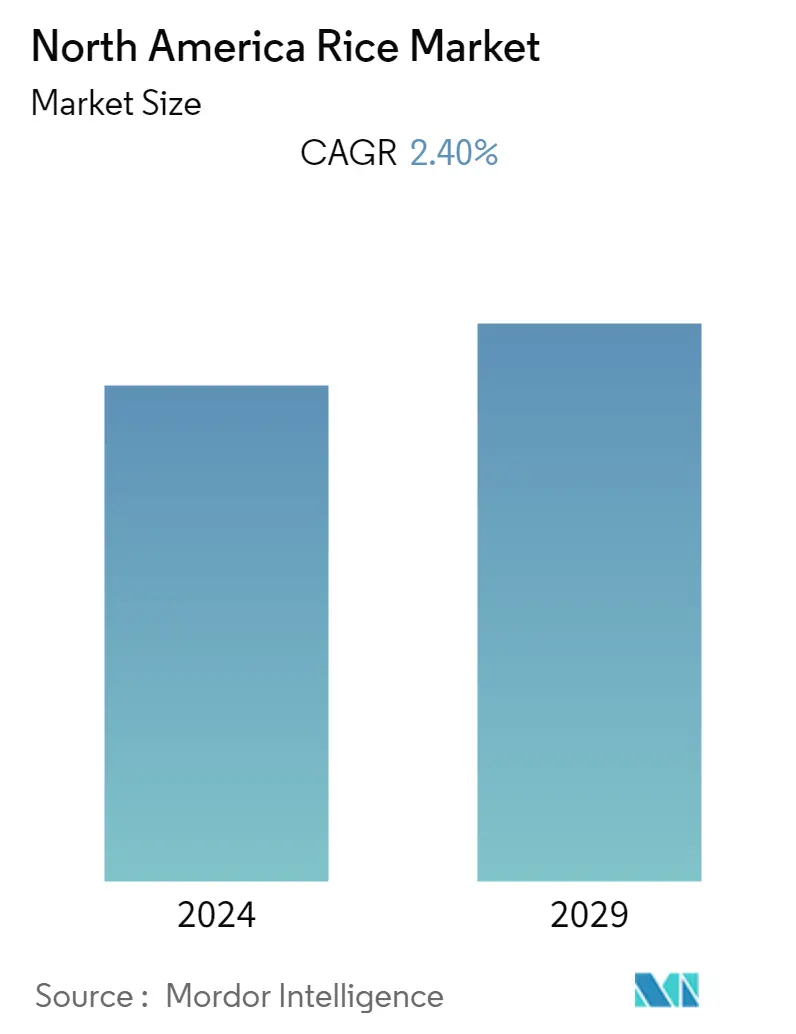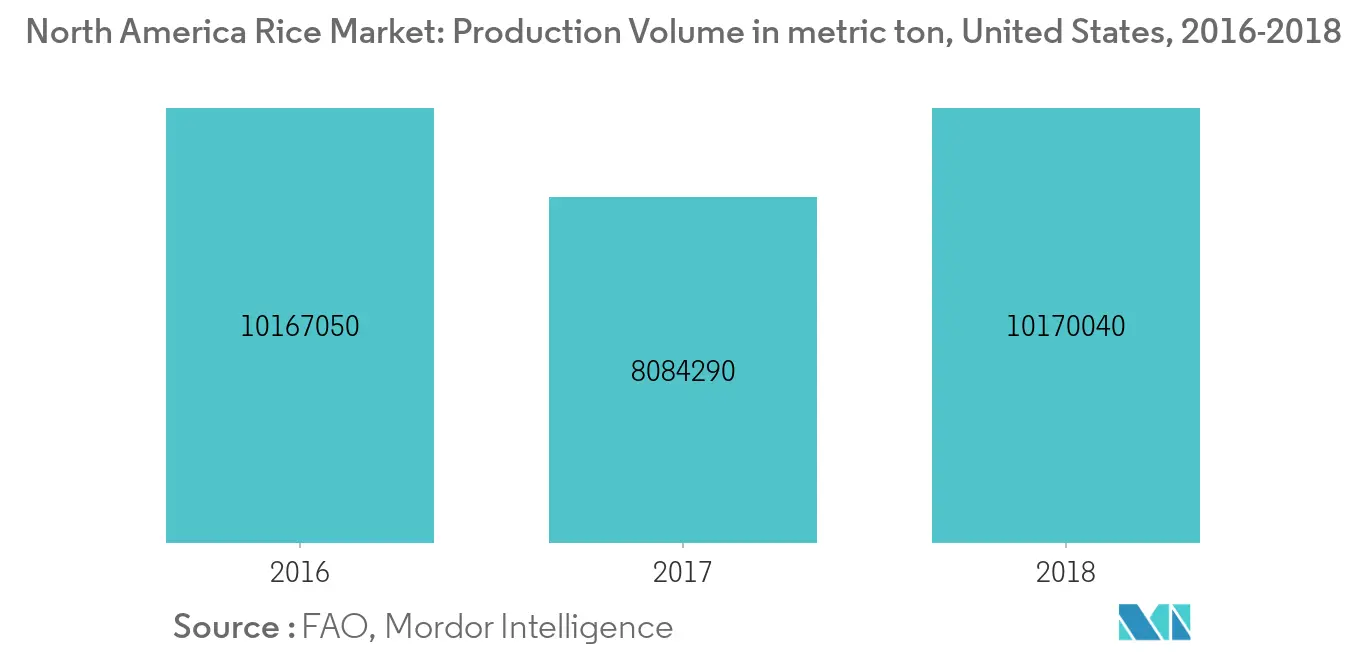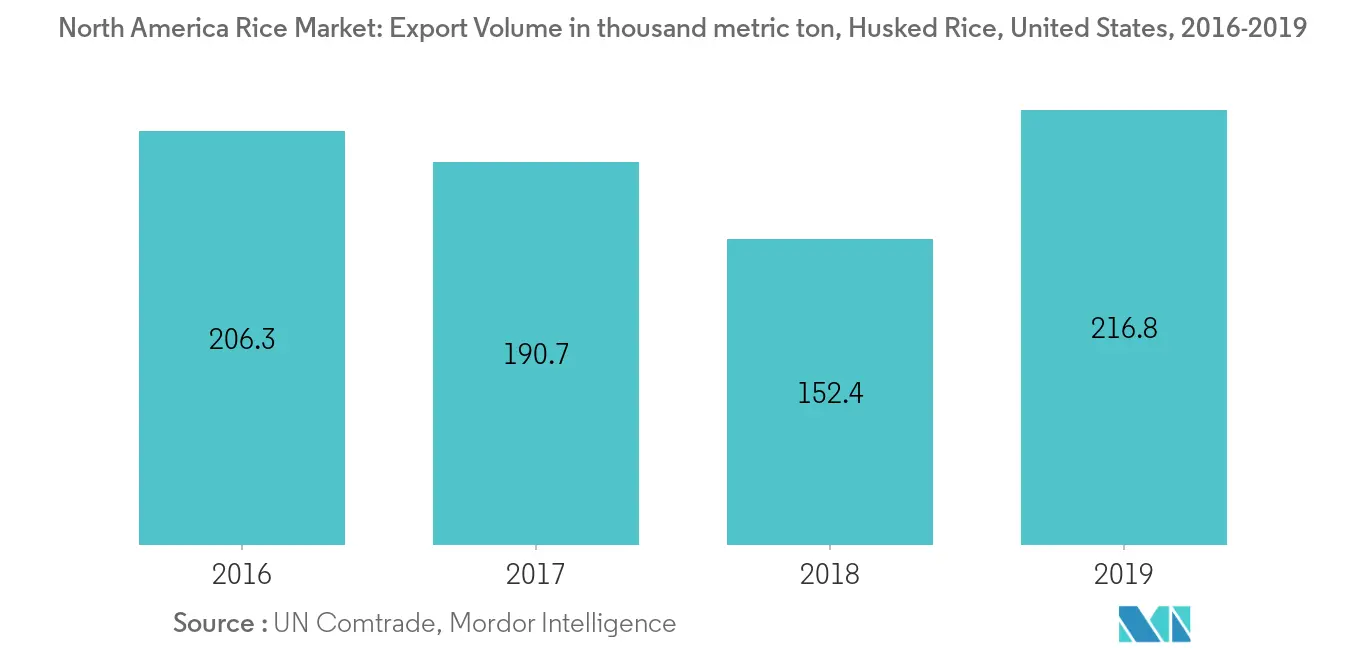North America Rice Market Size

| Study Period | 2019 - 2029 |
| Base Year For Estimation | 2023 |
| Forecast Data Period | 2024 - 2029 |
| Historical Data Period | 2019 - 2022 |
| CAGR | 2.40 % |
Major Players*Disclaimer: Major Players sorted in no particular order |
North America Rice Market Analysis
The North American rice market is projected to witness a CAGR of 2.4% during the forecast period (2020-2025). Over the recent years, the rice market has witnessed considerable growth on the back of the increasing demand for American rice in emerging and developing nations across the world, as North America is an export-oriented rice producer, but with considerably lower domestic consumption values. In addition to the support from the government, a few of the major factors responsible for the prosperity of the market include access to good inputs, good crop management systems, and advanced technology. These contribute to high-quality rice at harvest and the ability to maintain that quality throughout the milling and distribution chain. At the same time, highly efficient transportation and logistics contribute to the growth of the market in North America.
The United States is the major market for rice in North America, followed by Mexico and Canada. Arkansas Grand Prairie, Mississippi Delta, Gulf Coast, and Sacramento Valley of California are the major rice-producing areas in the United States. According to FAO, rice production in the United States was 10.1 million metric ton in 2018. Mexico is the second-largest rice market in the region, with 283.8 thousand metric ton of rice production in 2018.
North America Rice Market Trends
This section covers the major market trends shaping the North America Rice Market according to our research experts:
Support from Government and Other Associations
The increasing support from governmental and non-governmental organizations that are working for the betterment of the rice market is the second key factor responsible for the prosperity of the overall market in the region. Many US governments have offered support to producers through large procurement purchases, tariffs on imported rice, export incentives, and direct taxpayer subsidies based on production, prices, and historical acreage. These programs make rice one of the most heavily supported commodities in the countries, such as the United States, with ramifications for the US taxpayers and consumers and rice producers abroad.
Americans pay for the rice program three times over - as taxpayers, as consumers, and as workers. Direct taxpayer subsidies in the rice sector averaged from USD 1 billion a year from 1998 to USD 700 million annually through 2015. Similarly, Saskatchewan Crop Insurance Corporation (SCIC) has supported a wild rice crop insurance program since 2006. The coverage is based on the average production for the three wild rice-producing regions (Eastern, Central, and Western). Claims are triggered when the region reports annual production less than the average historical production, due to an insurable cause of loss, i.e., frost, wind, excessive rain, lightning, hurricane, tornado, insects, plant diseases, or hail.

The United States Dominates the Market
The United States is the major producer of rice in North America. Arkansas Grand Prairie, Mississippi Delta, Gulf Coast and Sacramento Valley of California are the major rice-producing areas in the United States. According to FAO, rice production in the United States was 10,167.0 thousand metric ton in 2016, which has increased to 10,170.0 thousand metric ton in 2018. Long grain, medium grain, and short-grain are the three major types of rice varieties produced in the country.
Increased production has paved way for higher export of rice. According to UN Comtrade, exports of husked rice by the United States were 206.3 thousand metric ton in 2016, which increased to 216.8 thousand metric ton in 2019. Korea, Taiwan, Canada, and Mexico are the major importers of rice from the United States in 2019, accounting for 57.4%, 15.0%, 13.4%, and 4.6%, respectively, in terms of volume. Promotional activities in Mexico and various international agreements between the United States and other countries, including Korea, Taiwan, and Nicaragua, were the major reasons for the boost in the export of rice in 2019. For instance, in 2019, the promotional activities and trade visits to Mexico boosted rice import from the United States by 15%.

North America Rice Market Report - Table of Contents
1. INTRODUCTION
- 1.1 Study Assumptions & Market Definition
- 1.2 Scope of the Study
2. RESEARCH METHODOLOGY
3. EXECUTIVE SUMMARY
4. MARKET DYNAMICS
- 4.1 Market Overview
- 4.2 Market Drivers
- 4.3 Market Restraints
- 4.4 Value Chain / Supply Chain Analysis
5. MARKET SEGMENTATION
-
5.1 Geography
- 5.1.1 North America
- 5.1.1.1 United States
- 5.1.1.1.1 Production Analysis
- 5.1.1.1.2 Consumption Analysis and Market Value
- 5.1.1.1.3 Import Analysis by Volume and Value
- 5.1.1.1.4 Export Analysis by Volume and Value
- 5.1.1.1.5 Price Trend Analysis
- 5.1.1.2 Canada
- 5.1.1.2.1 Production Analysis
- 5.1.1.2.2 Consumption Analysis and Market Value
- 5.1.1.2.3 Import Analysis by Volume and Value
- 5.1.1.2.4 Export Analysis by Volume and Value
- 5.1.1.2.5 Price Trend Analysis
- 5.1.1.3 Mexico
- 5.1.1.3.1 Production Analysis
- 5.1.1.3.2 Consumption Analysis and Market Value
- 5.1.1.3.3 Import Analysis by Volume and Value
- 5.1.1.3.4 Export Analysis by Volume and Value
- 5.1.1.3.5 Price Trend Analysis
6. MARKET OPPORTUNITIES AND FUTURE TRENDS
** Subject To AvailablityNorth America Rice Industry Segmentation
Rice is a primary staple crop for more than half the world's population, with Asia, Sub-Saharan Africa, and South American regions being the largest consumers. The North American rice market report offers key insights into the latest market developments. It analyzes the recent trends, drivers, and challenges affecting the rice market across the North American region. The North American rice market is analyzed by production, consumption, trade (import and export), price, and geography (United States, Canada, Mexico, and the Rest of North America).
| Geography | North America | United States | Production Analysis |
| Consumption Analysis and Market Value | |||
| Import Analysis by Volume and Value | |||
| Export Analysis by Volume and Value | |||
| Price Trend Analysis | |||
| Geography | North America | Canada | Production Analysis |
| Consumption Analysis and Market Value | |||
| Import Analysis by Volume and Value | |||
| Export Analysis by Volume and Value | |||
| Price Trend Analysis | |||
| Geography | North America | Mexico | Production Analysis |
| Consumption Analysis and Market Value | |||
| Import Analysis by Volume and Value | |||
| Export Analysis by Volume and Value | |||
| Price Trend Analysis |
North America Rice Market Research FAQs
What is the current North America Rice Market size?
The North America Rice Market is projected to register a CAGR of 2.40% during the forecast period (2024-2029)
What years does this North America Rice Market cover?
The report covers the North America Rice Market historical market size for years: 2019, 2020, 2021, 2022 and 2023. The report also forecasts the North America Rice Market size for years: 2024, 2025, 2026, 2027, 2028 and 2029.
North America Rice Industry Report
Statistics for the 2024 North America Rice market share, size and revenue growth rate, created by Mordor Intelligence™ Industry Reports. North America Rice analysis includes a market forecast outlook 2029 and historical overview. Get a sample of this industry analysis as a free report PDF download.



